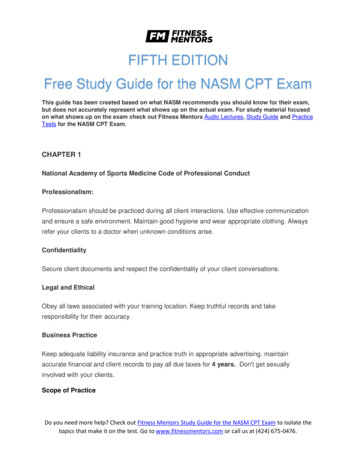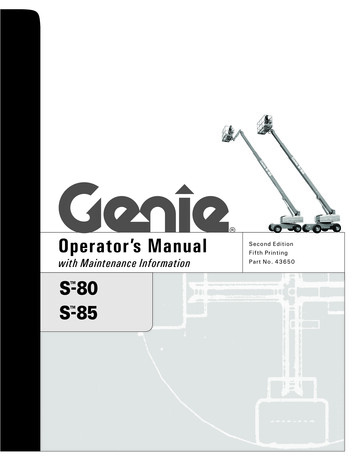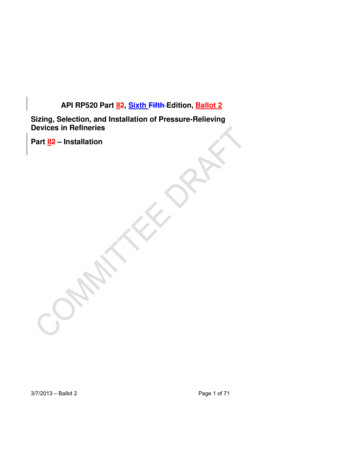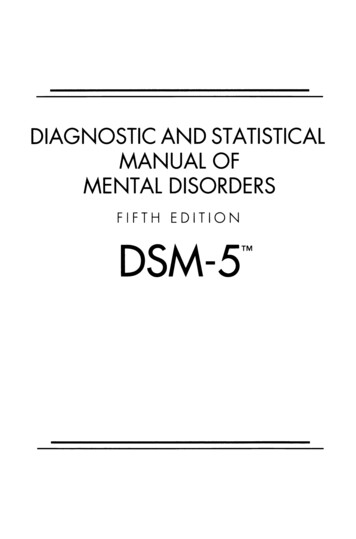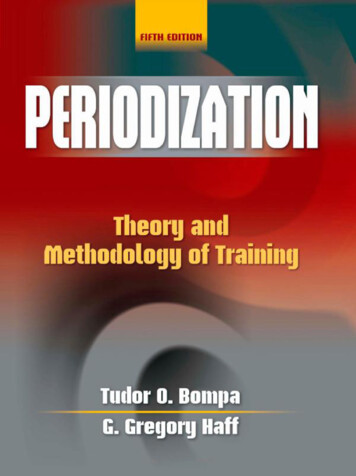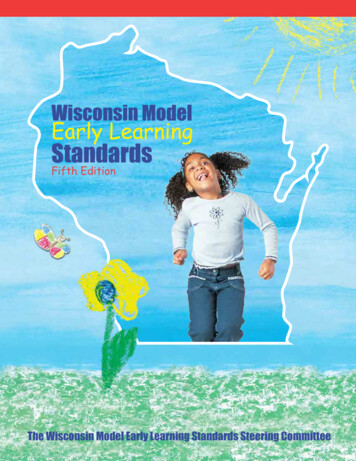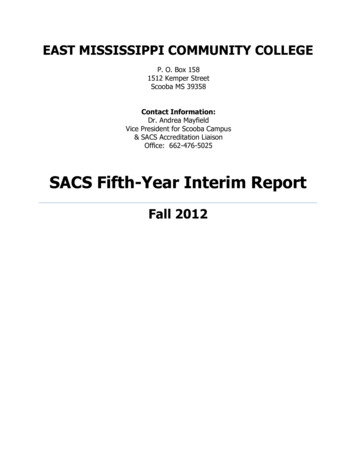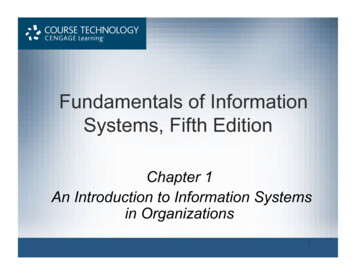
Transcription
Fundamentals of InformationSystems, Fifth EditionChapter 1An Introduction to Information Systemsin Organizations1
Principles and Learning Objectives The value of information is directly linked to how ithelps decision makers achieve the organization’sgoals– Distinguish data from information and describe thecharacteristics used to evaluate the value of dataFundamentals of Information Systems, Fifth Edition2
Principles and Learning Objectives(continued) Knowing the potential impact of informationsystems and having the ability to put thisknowledge to work can result in a successfulpersonal career and organizations that reach theirgoals– Identify the basic types of business informationsystems and discuss who uses them, how they areused, and what kinds of benefits they deliverFundamentals of Information Systems, Fifth Edition3
Principles and Learning Objectives(continued) System users, business managers, and informationsystems professionals must work together to builda successful information system– Identify the major steps of the systems developmentprocess and state the goal of eachFundamentals of Information Systems, Fifth Edition4
Principles and Learning Objectives(continued) The use of information systems to add value to theorganization can also give an organization acompetitive advantage– Identify the value-added processes in the supplychain and describe the role of information systemswithin them– Identify some of the strategies employed to lowercosts or improve service– Define the term competitive advantage and discusshow organizations are using information systems togain such an advantageFundamentals of Information Systems, Fifth Edition5
Principles and Learning Objectives(continued) Cooperation between business managers and ISpersonnel is the key to unlocking the potential ofany new or modified system– Define the types of roles, functions, and careersavailable in information systemsFundamentals of Information Systems, Fifth Edition6
Information Concepts Data, information, and knowledge– Data: Raw facts– Information: Collection of facts organized in such away that they have additional value beyond the valueof the facts themselves– Process: Set of logically related tasks performed toachieve a defined outcome– Knowledge: Awareness and understanding of a setof informationFundamentals of Information Systems, Fifth Edition7
Data, Information, and KnowledgeFundamentals of Information Systems, Fifth Edition8
Data, Information, and Knowledge(continued)Fundamentals of Information Systems, Fifth Edition9
Data, Information, and Knowledge(continued)Fundamentals of Information Systems, Fifth Edition10
The Characteristics of ValuableInformation If information is not accurate or complete– People can make poor decisions, costing thousands,or even millions, of dollars Information can be of little value to the organization– If information is not relevant, not delivered todecision makers in a timely fashion, or too complexto understandFundamentals of Information Systems, Fifth Edition11
The Value of Information Valuable information– Can help people and their organizations performtasks more efficiently and effectively– Can help managers decide whether to invest inadditional information systems and technologyFundamentals of Information Systems, Fifth Edition12
What Is an Information System? Feedback mechanism– The component that helps organizations achievetheir goals, such as increasing profits or improvingcustomer serviceFundamentals of Information Systems, Fifth Edition13
What Is an Information System?(continued)Fundamentals of Information Systems, Fifth Edition14
Input, Processing, Output, Feedback Input– Gathering and capturing raw data Processing– Converting or transforming data into useful outputs Output– Production of useful information, usually in the formof documents and reports Feedback– Output that is used to make changes to input orprocessing activitiesFundamentals of Information Systems, Fifth Edition15
Manual and Computerized InformationSystems An information system can be:– Manual Example: Developing patterns and trends on graphpaper for stock analysis– Computerized Example: Using program trading to track the marketand trade large blocks of stocks when discrepanciesoccurFundamentals of Information Systems, Fifth Edition16
Computer-Based Information Systems Single set of hardware, software, databases,telecommunications, people, and proceduresconfigured to collect, manipulate, store, andprocess data into information Information technology (IT)– Hardware, software, databases, andtelecommunicationsFundamentals of Information Systems, Fifth Edition17
Computer-Based Information Systems(continued)Fundamentals of Information Systems, Fifth Edition18
Computer-Based Information Systems(continued) CBIS components– Hardware: Computer equipment used to performinput, processing, and output activities– Software: Computer programs that govern theoperation of the computer– Database: Organized collection of facts andinformation– Telecommunications: Electronic transmission ofsignals for communications– Networks: Connect computers and equipment in abuilding, around the country, and around the worldFundamentals of Information Systems, Fifth Edition19
Computer-Based Information Systems(continued) CBIS components (continued)– Internet: World’s largest computer network– People: Manage, run, program, and maintain thesystem– Procedures: Strategies, policies, methods, andrules for using a CBISFundamentals of Information Systems, Fifth Edition20
Business Information Systems Most common types of information systems usedare those designed for:––––Electronic and mobile commerceTransaction processingManagement informationDecision supportFundamentals of Information Systems, Fifth Edition21
Business Information Systems(continued)Fundamentals of Information Systems, Fifth Edition22
Business Information Systems(continued)Fundamentals of Information Systems, Fifth Edition23
Electronic and Mobile Commerce E-commerce– Any business transaction executed electronicallybetween: Companies (B2B)Companies and consumers (B2C)Consumers and other consumers (C2C)Business and the public sectorConsumers and the public sectorFundamentals of Information Systems, Fifth Edition24
Electronic and Mobile Commerce(continued) Mobile commerce (m-commerce)– Transactions conducted anywhere, anytime Electronic business (e-business)– Uses information systems and the Internet toperform all business-related tasks and functionsFundamentals of Information Systems, Fifth Edition25
Electronic and Mobile Commerce(continued)Fundamentals of Information Systems, Fifth Edition26
Electronic and Mobile Commerce(continued)Fundamentals of Information Systems, Fifth Edition27
Enterprise Systems: TransactionProcessing Systems and EnterpriseResource Planning Transaction– Any business-related exchange Transaction processing system (TPS)– Organized collection of people, procedures,software, databases, and devices used to recordcompleted business transactions Enterprise resource planning– Programs that manage the vital business operationsfor an entire multisite, global organizationFundamentals of Information Systems, Fifth Edition28
Enterprise Systems: TransactionProcessing Systems and EnterpriseResource Planning (continued)Fundamentals of Information Systems, Fifth Edition29
Information and Decision SupportSystems Management information systems– Organized collection of people, procedures,software, databases, and devices– Provides routine information to managers/decisionmakers Decision support systems– Organized collection of people, procedures,software, databases, and devices that supportproblem-specific decision makingFundamentals of Information Systems, Fifth Edition30
Information and Decision SupportSystems (continued)Fundamentals of Information Systems, Fifth Edition31
Information and Decision SupportSystems (continued)Fundamentals of Information Systems, Fifth Edition32
Specialized Business InformationSystems: Knowledge Management,Artificial Intelligence, Expert Systems,and Virtual Reality Knowledge management systems (KMSs)– Organized collection of people, procedures,software, databases, and devices Artificial intelligence (AI)– Field in which the computer system takes on thecharacteristics of human intelligence– Robotics, vision systems, and natural languageprocessingFundamentals of Information Systems, Fifth Edition33
Specialized Business InformationSystems: Knowledge Management,Artificial Intelligence, Expert Systems,and Virtual Reality (continued)Fundamentals of Information Systems, Fifth Edition34
Specialized Business InformationSystems: Knowledge Management,Artificial Intelligence, Expert Systems,and Virtual Reality (continued) Expert systems– Give the computer the ability to make suggestionsand act like an expert in a particular field Virtual reality– The simulation of a real or imagined environmentthat can be experienced visually in three dimensionsFundamentals of Information Systems, Fifth Edition35
Systems Development Creating or modifying existing business systems Systems development failures can be a result of:––––Poor planning and schedulingInsufficient management of riskPoor requirements determinationLack of user involvement Outsourcing– Allows a company to focus on what it does best anddelegate other functionsFundamentals of Information Systems, Fifth Edition36
Systems Development (continued)Fundamentals of Information Systems, Fifth Edition37
Systems Investigation and Analysis Systems investigation– Goal is to gain understanding of the problem to besolved or opportunity to be addressed Systems analysis– Defines problems and opportunities of the existingsystemFundamentals of Information Systems, Fifth Edition38
Systems Design, Implementation, andMaintenance and Review Systems design– Determines how the new system will work to meetthe business needs defined during systems analysis Systems implementation– Creating or acquiring the system componentsdefined in the design step, assembling them, andputting the new system into operation Systems maintenance and review– Checking and modifying the system so that itcontinues to meet changing business needsFundamentals of Information Systems, Fifth Edition39
Organizations and InformationSystems Organization– Collection of people and other resources establishedto accomplish a set of goals– Has inputs, processing mechanisms, outputs, andfeedbackFundamentals of Information Systems, Fifth Edition40
Organizations and InformationSystems (continued)Fundamentals of Information Systems, Fifth Edition41
Organizations and InformationSystems (continued) Value chain– Series of activities that includes inbound logistics,warehouse and storage, and production Supply chain management (SCM)– Helps determine what supplies are required for thevalue chain and what quantities are needed to meetcustomer demand Customer relationship management (CRM)– Helps companies manage all aspects of customerencounters, including marketing and advertisingFundamentals of Information Systems, Fifth Edition42
Organizations and InformationSystems (continued)Fundamentals of Information Systems, Fifth Edition43
Organizational Culture and Change Organizational culture– Major understandings and assumptions– The understandings are often not stated ordocumented as goals or formal policies Organizational change– How organizations plan for, implement, and handlechange– Can be sustaining or disruptiveFundamentals of Information Systems, Fifth Edition44
User Satisfaction and TechnologyAcceptance Technology acceptance model (TAM)– Specifies factors that can lead to higher acceptanceand usage of technology Technology diffusion– Measure of widespread use of technology Technology infusion– Extent to which technology permeates a departmentFundamentals of Information Systems, Fifth Edition45
Competitive Advantage Significant, long-term benefit to a company over itscompetition An organization often uses its information systemto help achieve a competitive advantageFundamentals of Information Systems, Fifth Edition46
Factors That Lead Firms to SeekCompetitive Advantage Five-forces model identifies key factors–––––Rivalry among existing competitorsThreat of new entrantsThreat of substitute products and servicesBargaining power of buyersBargaining power of suppliersFundamentals of Information Systems, Fifth Edition47
Strategic Planning for CompetitiveAdvantage Cost leadership– Deliver the lowest possible products and services Differentiation– Deliver different products and services Niche strategy– Deliver to a small, niche market Altering the industry structure– Change the industry to become more favorable toorganizationFundamentals of Information Systems, Fifth Edition48
Strategic Planning for CompetitiveAdvantage (continued) Creating new products and services– Introduce periodically or frequently Improving existing product lines and service– Make real or perceived improvements Other strategies––––Growth in salesFirst to marketCustomizing products and servicesHiring the best peopleFundamentals of Information Systems, Fifth Edition49
Performance-Based InformationSystems Three major stages– Organizations focused on using information systemsto reduce costs and improve productivity– Companies generally ignored revenue potential, notlooking for opportunities to use information systemsto increase sales– Companies carefully consider both strategicadvantage and costsFundamentals of Information Systems, Fifth Edition50
Performance-Based InformationSystems (continued)Fundamentals of Information Systems, Fifth Edition51
Productivity Output achieved divided by input required Higher level of output for a given level
An information system can be: – Manual Example: Developing patterns and trends on graph paper for stock analysis – Computerized Example: Using program trading to track the market and trade large blocks of stocks when discrepancies occur . Fundamentals of Information Systems, Fifth Edition 17 Computer-Based Information Systems Single set of hardware, software, databases .


